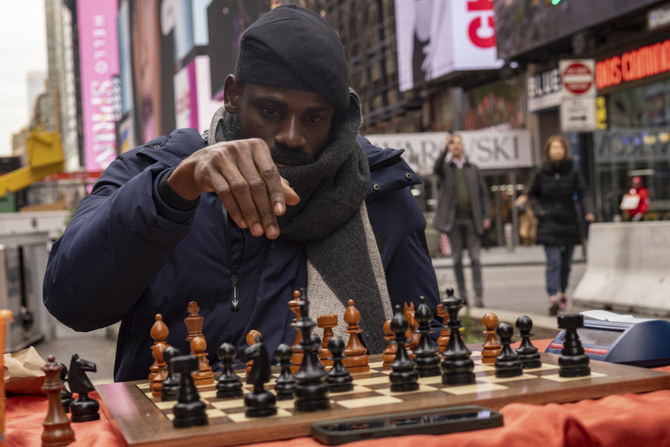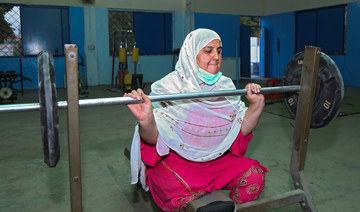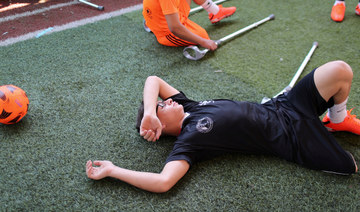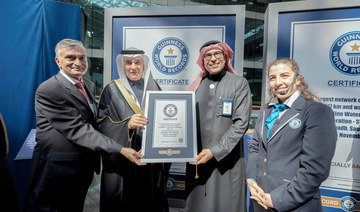BAGHDAD: As a seven-year-old boy in Baghdad, Mohamed Ali dreamt of becoming a goalkeeper — until a car bomb in the central Tahrir Square ripped away his left arm.
The child had become another casualty of the sectarian blood-letting that raged in Iraq in the years after the 2003 US-led invasion that toppled Saddam Hussein.
“I was deprived of playing football,” he said, recalling the traumatic event of 2007 that also ended his time with the junior football team of the Air Force Club in Baghdad.
Today, at age 22, Ali is a member of an all-amputee football team, made up entirely of players who lost arms or legs in Iraq’s many years of war and turmoil.
“The creation of this team brought me back to life,” he said. “It helped me regain my self-confidence.”
The team has some 30 players and has qualified for the Amputee Football World Cup to be held in Turkey in late 2022.
Its founder Mohamed Al-Najjar was studying in England when he discovered a Portsmouth amputee team and decided to replicate the experience.
Back in Iraq, he posted an announcement on social networks.
“Applications started pouring in and we formed the team in August 2021,” recalls the 38-year-old lawyer.
Najjar’s right leg was amputated after he was wounded in 2016 “while taking part in the fight against the Daesh group.”
At the time Najjar, like several of his teammates, was fighting with the pro-Iranian Hashed Al-Shaabi, a paramilitary force that has since been integrated into Iraq’s regular forces.
Three times a week, he now meets up with the group to train on one of the fields of the brand new Al-Chaab complex in Baghdad.
Using crutches, one-legged players warm up by sprinting in the green jersey of the national team, then practice penalty kicks.
The goalkeeper, his left arm amputated, intercepts the ball by blocking it with his stomach.
Before they found the camaraderie of the team, Najjar said, “most of the players were suffering from severe depression.”
“Some even had thought of suicide because they had lost a limb and they had been professional players before.
“But we overcame these psychological problems,” he said, adding that it pleased him to now see his players “posting their pictures with the team on social networks.”
In the official competition, matches are played in teams of seven on fields measuring 60 by 40 meters (about 200 by 130 feet).
The goals are two meters high and five meters wide — smaller than the 2.4 by 7.3 meter goals used in traditional football.
The Iraqi state offers financial aid to victims of attacks and of battles against jihadists. The players receive monthly allowances of between $400 and $700.
Most make ends meet by working as day laborers in the markets, said Najjar.
But a major obstacle for the team is a lack of official recognition, and therefore funding, from Iraqi sports bodies.
The Poland-based International Amputee Football Federation is not part of the International Paralympic Committee.
The Iraqi team therefore receives no state subsidies, said Aqil Hamid, the head of the parliamentary committee on disability sports.
For equipment and transport, the team depends on donations from associations, said Najjar. There is also occasional help from some Hashed bodies.
“They helped us with a trip to Iran, they paid for the plane tickets,” said Najjar, adding that he hoped for “wider support.”
Another team member, Ali Kazim, lost his left leg to a Baghdad car bomb in 2006, which abruptly ended his professional football career with the Air Force Club.
“I couldn’t pursue my ambitions, I stayed at home,” said the 38-year-old.
Today, his four children are his biggest supporters.
“They are the ones who pack my sports bag,” he said. “They tell me: ‘Daddy, go train’. My morale has totally changed.”
For Iraqi amputees football team, healing is the goal
https://arab.news/c4x2y
For Iraqi amputees football team, healing is the goal

- Today, at age 22, Ali is a member of an all-amputee football team, made up entirely of players
- The team has some 30 players and has qualified for the Amputee Football World Cup to be held in Turkey in late 2022
A Nigerian chess champion is trying to break the world record for the longest chess marathon

- Tunde Onakoya, 29, is playing against Shawn Martinez, an American chess champion, in line with Guinness World Record
- Onakoya, who founded Chess in Slums Africa, hopes to raise $1 million for children’s education across Africa
NEW YORK: A Nigerian chess champion and child education advocate is attempting to play chess nonstop for 58 hours in New York City’s Times Square to break the global record for the longest chess marathon.
Tunde Onakoya, 29, hopes to raise $1 million for children’s education across Africa. He is playing against Shawn Martinez, an American chess champion, in line with Guinness World Record guidelines that any attempt to break the record must be made by two players who would play continuously for the entire duration.
Onakoya had played chess for 42 hours by 10:00 a.m. GMT on Friday. Support is growing online and at the scene, where a blend of African music is keeping onlookers and supporters entertained amid cheers and applause.
The current chess marathon record is 56 hours, 9 minutes and 37 seconds, achieved in 2018 by Hallvard Haug Flatebø and Sjur Ferkingstad, both from Norway.
The record attempt is “for the dreams of millions of children across Africa without access to education,” said Onakoya, who founded Chess in Slums Africa in 2018. The organization wants to support education of at least 1 million children in slums across the continent.
“My energy is at 100 percent right now because my people are here supporting me with music,” Onakoya said Thursday evening after the players crossed the 24-hour mark.
On Onakoya’s menu: Lots of water and jollof rice, one of West Africa’s best known dishes.
For every hour of game played, Onakoya and his opponent get only five minutes’ break. The breaks are sometimes grouped together, and Onakoya uses them to catch up with Nigerians and New Yorkers cheering him on. He even joins in with their dancing sometimes.
A total of $22,000 was raised within the first 20 hours of the attempt, said Taiwo Adeyemi, Onakoya’s manager.
“The support has been overwhelming from Nigerians in the US, global leaders, celebrities and hundreds of passersby,” he said.
Onakoya’s attempt is closely followed in Nigeria where he regularly organizes chess competitions for young people living on the streets to boost his cause. More than 10 million children are out of school in the West African country — one of the world’s highest rates.
Among those who have publicly supported him are celebrities and public office holders, including Nigeria’s former Vice President Yemi Osinbajo, who wrote to Onakoya on X, formerly Twitter: “Remember your own powerful words: ‘It is possible to do great things from a small place.’“
The Guinness World Record organization has yet to publicly comment about Onakoya’s attempt, which could reach 58 hours by midnight on Friday. It sometimes takes weeks for the organization to confirm any new record.
Used missiles for sale: Iranian weapons used against Israel are up for grabs on Jordan-based website
Used missiles for sale: Iranian weapons used against Israel are up for grabs on Jordan-based website

- Debris used in attack listed on OpenSooq online marketplace
LONDON: Fragments of missiles launched by Iran during the recent attack on Israel have been discovered for sale on Jordan’s prominent OpenSooq website, which is known for trading goods, including vehicles and real estate.
Al Arabiya reported on Sunday that the shrapnel was being advertised, with pieces described as “Used Iranian ballistic missile in good condition for sale,” and “One-time use ballistic missile for sale at an attractive price.”
The sellers had provided specifications and images of the missiles, describing them as “excellent type,” and mentioned their involvement in an “accident” resulting in “severe damage to the body.”
Some listings even included installment payment options.
Iran launched drones and missiles toward Israel late on Saturday as it retaliated following a suspected Israeli strike on the consulate annex building adjacent to the Iranian Embassy in Damascus, Syria, earlier this month.
While most projectiles were intercepted by a joint response from Israel, the US, UK, France, and Jordan, the attack marked Iran’s first direct military assault on Israeli territory, escalating tension and uncertainty in the region.
Following the attack, individuals shared photographs online showing debris that had fallen on Jordanian territory in areas such as Al-Hasa, Marj Al-Hamam, and Karak Governorate.
The Jordanian government confirmed that it had intercepted some flying objects in its airspace, with no reported damage or injuries.
Debris from such incidents often holds economic value. Metal debris from the Iraq War has been used by Iran-backed groups to finance their activities.
Similar items are sold online as military memorabilia, and there has been a surge in demand for such artifacts, as seen in Australia last year, preceding the country’s ban on the sale of hate symbols.
Google Doodle celebrates Lebanese-American poet and artist Etel Adnan

- Etel Adnan rose to fame for her 1977 novel Sitt Marie Rose about the Lebanese civil war
DUBAI: Google released its latest Doodle on Monday honoring Etel Adnan, a Lebanese-American poet, essayist and visual artist, considered one of the most accomplished Arab-American authors of her era.
The poet, who rose to fame for her 1977 novel Sitt Marie Rose about the Lebanese civil war, was born in Lebanon in 1925 to a Greek mother and a Syrian father, and grew up in multiple cultures, languages, nationalities and religions. Sitt Marie Rose won the France-Pays Arabes award and become a classic of war literature, so much so that it is taught in American classrooms.
In 1949, Adnan went to Paris to study philosophy at the Sorbonne before going to America to study at Harvard and Berkeley.
From 1958 to 1972, she taught philosophy in California, during which time she also started painting and writing poetry. She developed her literary voice in English and said abstract painting was the entry point into her native Arabic.
Adnan returned to Beirut, where from 1972 to 1976 she worked as the arts editor for two newspapers. She returned to California in 1979, then spent her later years living between Paris and Beirut.
In 2003, Adnan was named “arguably the most celebrated and accomplished Arab American author writing today” by the academic journal MELUS: Multi-Ethnic Literature of the United States.
Adnan’s most recent honor was in 2020. Her poetry collection “Time,” which is a selection of her work — translated from French by Sarah Riggs — won the Griffin Poetry Prize.
The King Abdulaziz Center for World Culture, or Ithra, earlier this year opened an eponymous exhibition in her honor – “Etel Adnan: Between East and West” – showcasing 41 of her works. The space at Ithra’s gallery is the first solo exhibition of Adnan’s work in Saudi Arabia, running until June 30.
The works on display span from the beginning of Adnan’s artistic career in the late 1950s through to her final creations in 2021, shortly before her death that year aged 96.
Some of the works are on loan from significant international institutions such as the Sharjah Art Foundation, Sfier-Semler Gallery and Sursock Museum. Some are part of private collections.
‘HELP’ written in palm fronds lands rescue for Pacific castaways

- The trio became stranded on Pikelot Atoll, a tiny island in the remote Western Pacific, after their motor-powered skiff malfunctioned
- A US Navy aircraft saw the "help" sign and a ship came later to rescue the stranded trio, all experienced mariners in their 40s
LOS ANGELES: Sometimes all you have to do is ask for “HELP“: That’s what three men stranded on a deserted Pacific island learned earlier this week, writing the message in palm fronds which were spotted by US rescuers.
The trio, all experienced mariners in their 40s, became stranded on a lonely island after setting off from Micronesia’s Polowat Atoll on March 31 in their motor-powered skiff which subsequently experienced damage.
They were reported missing last Saturday by a woman who told the US Coast Guard her three uncles never returned from Pikelot Atoll, a tiny island in the remote Western Pacific.
“In a remarkable testament to their will to be found, the mariners spelled out ‘HELP’ on the beach using palm leaves, a crucial factor in their discovery,” said search and rescue mission coordinator Lt. Chelsea Garcia.
She reported that the trio was discovered Sunday on Pikelot Atoll by a US Navy aircraft.
“This act of ingenuity was pivotal in guiding rescue efforts directly to their location,” she said.
The aircraft crew dropped survival packages, and rescuers one day later dropped a radio which the mariners used to communicate that they were in good health, had access to food and water, and that the motor on their 20-foot (six-meter) skiff was no longer working.
On Tuesday morning a ship rescued the trio and their equipment, returning them to Polowat Atoll, the Coast Guard said.
In August 2020, three Micronesian sailors also stranded on Pikelot were rescued after Australian and US warplanes spotted a giant “SOS” they had scrawled on the beach.
Dining hall with Trojan War decorations uncovered in ancient Roman city of Pompeii

- One fresco depicts Paris and Helen, whose love affair caused the Trojan War, according to classical accounts
- Pompeii and the surrounding countryside was submerged by volcanic ash when Mount Vesuvius exploded in AD 79
ROME: A black-walled dining hall with 2,000-year-old paintings inspired by the Trojan War has been discovered during excavations at the Roman city of Pompeii, authorities said on Thursday.
The size of the room — about 15 meters long and 6 meters wide — the quality of the frescoes and mosaics from the time of Emperor Augustus, and the choice of characters suggest it was used for banquets, Pompeii Archaeological Park said.

“The walls were painted black to prevent the smoke from the oil lamps being seen on the walls,” Gabriel Zuchtriegel, head of the park, said.
“People would meet to dine after sunset, and the flickering light of the lamps had the effect of making the images appear animated, especially after a few glasses of good Campanian wine.”
Pompeii and the surrounding countryside was submerged by volcanic ash when Mount Vesuvius exploded in AD 79, killing thousands of Romans who had no idea they were living beneath one of Europe’s biggest volcanoes.
The site has seen a burst of archaeological activity aimed at halting years of decay and neglect, largely thanks to a 105-million-euro ($112 million) European Union-funded project.

The dominant theme of the newly discovered paintings is heroism and fate.
One fresco depicts Paris and Helen, whose love affair caused the Trojan War, according to classical accounts. Another one shows doomed prophetess Cassandra and the Greco-Roman god Apollo.
According to Greek mythology, Cassandra predicted the Trojan War after receiving the gift of foresight from Apollo, but no-one believed her. This was because of a curse Apollo put upon her for refusing to give herself to him.




















